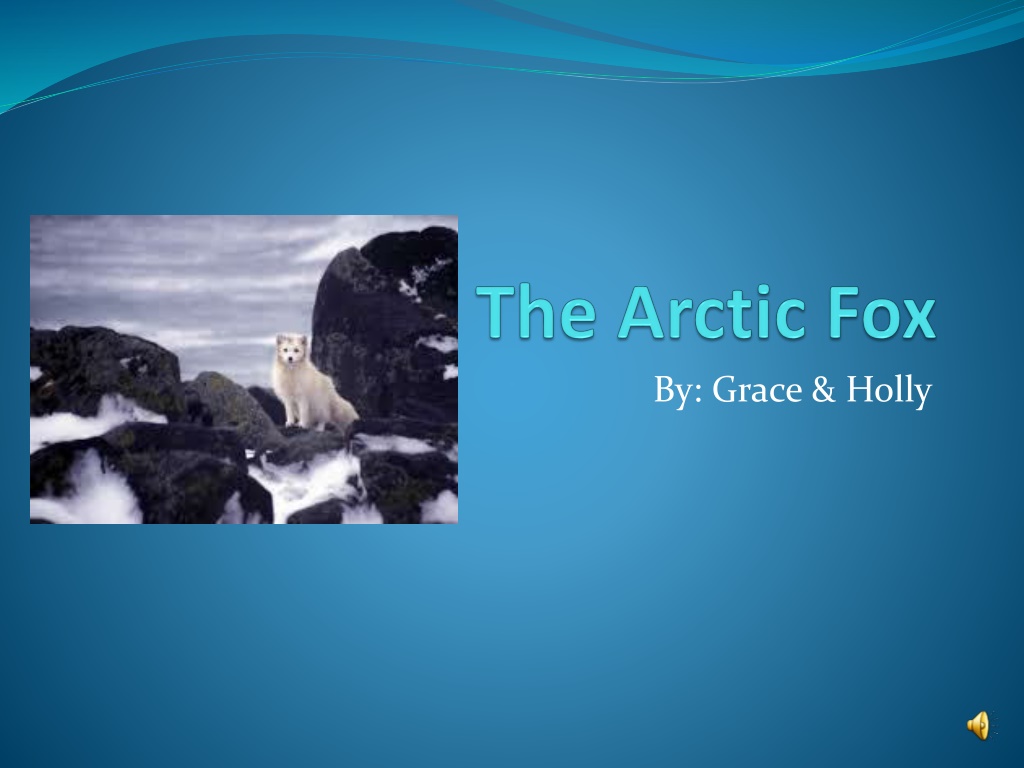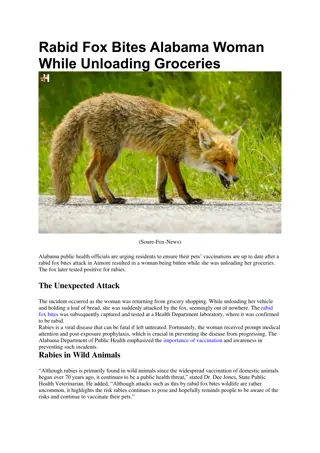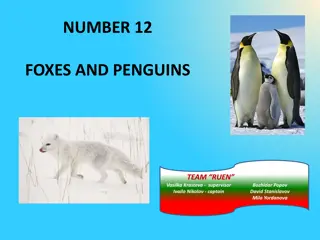
Fascinating Insights into the Arctic Fox
Discover the remarkable adaptations, habitats, appearance, diet, reproduction habits, and population trends of the Arctic fox. Explore how these majestic creatures survive in cold environments and learn about the threats they face, including habitat loss and hunting. Find out ways to help conserve this species and raise awareness to prevent their extinction.
Download Presentation

Please find below an Image/Link to download the presentation.
The content on the website is provided AS IS for your information and personal use only. It may not be sold, licensed, or shared on other websites without obtaining consent from the author. If you encounter any issues during the download, it is possible that the publisher has removed the file from their server.
You are allowed to download the files provided on this website for personal or commercial use, subject to the condition that they are used lawfully. All files are the property of their respective owners.
The content on the website is provided AS IS for your information and personal use only. It may not be sold, licensed, or shared on other websites without obtaining consent from the author.
E N D
Presentation Transcript
Classification: To live in such cold places, Arctic foxes have several adaptations that allow them to survive. Their round, compact bodies minimize surface area that is exposed to the cold air. Their muzzle, ears, and legs are short, which also conserves heat.
Habitats: The Arctic fox is found throughout the entire Arctic tundra, through Alaska, Canada, Greenland, Russia, Norway, Scandinavia, and even Iceland, where it is the only native land mammal.
Appearance: Of course, the defining feature of the Arctic fox is their deep, thick fur which allows them to maintain a consistent body temperature. Arctic foxes also have thick fur on their paws, which allows them to walk on both snow and ice. Fox in summer: Fox in winter:
Diet: Lemmings are the staple food for Arctic foxes. However, they are quite opportunistic, and will eat whatever is available out on the frozen tundra, even if it means scavenging leftovers from other predators, such as polar bears!
Reproduction: Mating season for Arctic foxes usually lasts from early September to early May. Litters are usually between 5-9 pups, though much larger litters aren't uncommon. Arctic foxes usually mate for life, and both mother and father help raise the pups.
Interesting Fact: Arctic fox populations range in the hundred thousands, but fluctuate with the available lemming population.
How To Save The Arctic Fox: The arctic fox has many problems but in this paper I'm going to tell you about 3. The poor arctic fox's habitat is melting away, there being hunted, and carless things we do. I'll also give you some helpful ideas on how to save them. We can save them and raise awareness about the killing. If people like you don't help then pretty soon they will be extinct. Then our cute white fuzzy friends will be gone. 1 of the reasons the arctic fox's are dying is because people are hunting them for fame, fortune, and warmth. How I see it people should think about it the other way around what if we where the ones being hunted we wouldn't like it so don't hunt them. The second reason is the arctic fox's habitat is melting away. We can help by turning off electricity when we don't need it. This also goes into my third reason the carless things we're doing such as leaving on electricity when we don't need it on and eating out eating food that's not necessary and on. These are ways we can help the arctic fox stay on the planet. You can do these things with a parents or guardians permission. 1.Send money to an arctic fox conservation center 2..You can also adopt an arctic fox PLEASE HELP!!!!=)
How Foxes are Affected by Global Warming: Polar bears may not be the only Arctic wildlife threatened by global warming. Scientists have discovered that Arcticfoxes also struggle as the ice disappears because they rely on the frozen seas to survive the bleak winters. Researchers tracked the movements of 14 young foxes as they faced their first Arctic winter in northern Alaska, where the temperature plunges to - 30C and it is dark for 24 hours a day. Only three animals survived the winter, by wandering hundreds of miles across the frozen sea ice looking for seal carcasses left by polar bears. The 11 foxes that remained on the mainland perished. The scientists said taking to the ice could help foxes survive because there were fewer predators and food was easier to find than on land. But they said the discovery raised new concerns over the foxes' survival in the face of diminishing Arctic ice cover. Sea ice in the Arctic region, formed from frozen seawater, has shrunk dramatically in recent years and could reach a new record low this summer.






















